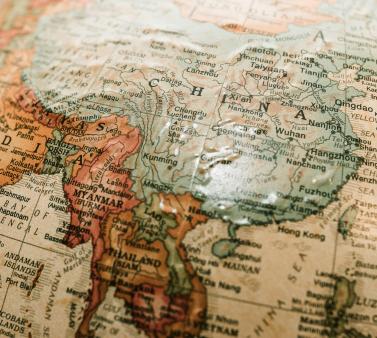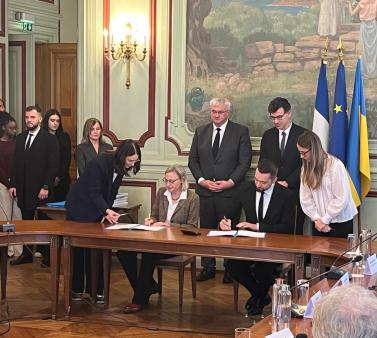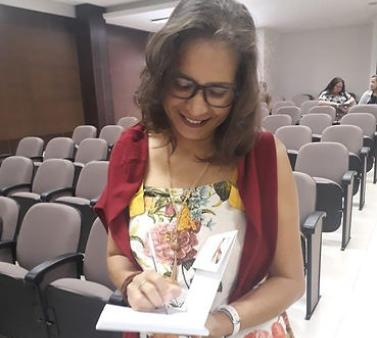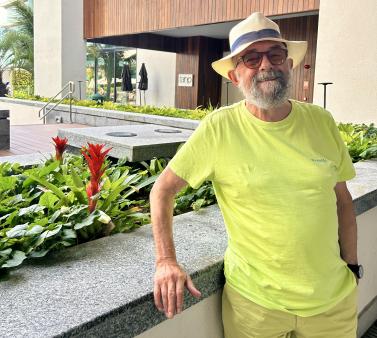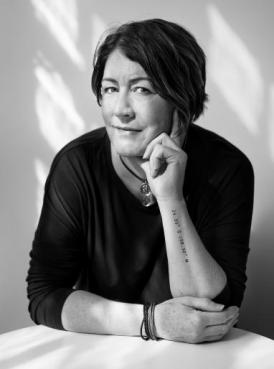
Mandy Barker © Knut Koivisto
Mandy Barker's photographic series Plastic sea focuses on the mass accumulation of plastic debris in our seas and oceans. The aim of this work is to establish a dialogue with the viewer, to awaken his or her consciousness by creating an emotional contradiction between the initial aesthetic attraction and the horror of what is shown.
All the plastic photographed was recovered from beaches around the world, from the North Pacific Ocean to the South China Sea, via the seas of Europe. These collections and groupings of debris are arranged to recreate the sensation of suspension in the water, symbolizing the boundless pollution that eventually replaces all forms of marine life.
Read our interview with Mandy Barker below.
Your work has been exposed in more than 50 countries and published in The National Geographic Magazine, The TIME Magazine and in The British Journal of Photography. Can you tell us about your career pathway as an artist ?
Mandy Barker: My concern with marine plastic started in 2008 when I began to notice that on the shoreline natural objects like shells and driftwood were being replaced with man-made waste, especially plastic. Not only single-use plastic objects, but household appliances such as fridge freezers, computers, tv’s, etc, were washing up on the beach of my local nature reserve and became concerned with how they got there. It was the environmental impact that worried me and is what initially stimulated my work, to raise awareness of my own experience. At the same time I had enrolled for a Masters course in Photography and felt this was the perfect way to share the issue with a wider audience.
The exposition Plastic sea required a big process of inventory, selection and composition of the debris collected from beaches around the world. How did you manage to collect this material and what was your creative process ? What made you choose the final ranking ?
MB: Initially I collect information by reading academic research journals and attending international conferences. Working directly with scientific experts who are studying the problem first hand, is a key aspect of the research process for me.This inspires my work, whether it is a particular species or area that is affected, or a particular type of plastic or object that is having a detrimental effect on biodiversity. I develop my thought process through sketchbook journals, which enable my ideas to come together. I then collect the marine plastic from beaches and oceans around the world – sometimes from a specific beach and with similar objects or colours depending on the project. I photograph the plastic back in my studio by randomly scattering the pieces on a black background, sometimes creating several layers which are then sandwiched together. The images are intended to be attractive to draw the viewer in to see what the objects are, once the viewer has read the caption, this contradiction alongside the shocking caption hopefully creates the subsequent message of awareness. The images selected for the exhibition were chosen to reflect the different types of objects found in the sea, but also to reflect the wider global locations where they were recovered.

Soup, Birds Nest © Mandy Barker
You took part in several scientific expeditions in particular with the NGO Greenpeace and with UNESCO. The images you produce are always based on scientific facts. What do you think of this collaboration between arts and sciences ?
MB: My work has to be accurate if it is to be believed. It is essential to the integrity of my work that I don't distort information for the sake of making an interesting image and that I return the trust shown to me by the scientists who have supported my work. Although aesthetics are important, it has more to do with representing the facts of how we are affecting our planet and changing environments.
Science is not subjective as it is factual with no room for aesthetics or emotion, so in that sense the work of an artist and a scientist are opposed in approach, but in some way are seeking to achieve the same outcome. My work visually represents the issue whilst being true to the facts and raises awareness amongst people who perhaps would not get to read such articles or have the opportunity to visit affected areas, like the middle of the North Pacific. In this way my work can help to give science a visual voice whilst hopefully connecting with the viewer’s social conscience.
That photographic series creates an emotional contradiction between the aesthetics which initially appears and the ugliness of what is denounced. What emotions did you want to provoke?
The images are intentionally presented in a visually attractive way to draw the viewer in to look at the work, then to shock them with the captions and facts of what is being represented. To make the public aware of the detrimental impacts of marine plastic as both a climate change issue, the effects on biodiversity and ultimately ourselves, I hope this connection with a wider audience will in some way help to inspire change. Photography is a form of communication that has the ability to educate, inform, and increase awareness, if it has the power to encourage people to act, to move them emotionally, or at the very least make them take notice, then this must surely be a vital element to stimulate debate, and ultimately change. If I didn’t believe my work did any of these things then I wouldn’t be motivated to continue.

Soup, 500+ © Mandy Barker
According to the ocean defense NGO Sea Shepherd “12 to 15 million tons of plastic ends up in the ocean each year, killing one million seabirds and 100,000 marine animals”. In 2024, a global treaty against plastic pollution will be published, initiated by the United Nations Assembly with the aim of combating plastic pollution on an international scale. Do you think that the policies put in place are up to the problem?
There are endless shocking statistics about the way plastic affects birds, and marine life, there is nothing more distressing than picking up a recently deceased bird from the shoreline to feel plastic crunch in its stomach and know this was the cause of death. We have become dependent on plastic and as humans microplastic is now in our organs, our blood and the placentas of unborn babies.
We have to hope that the negotiators that meet again in Paris in November to discuss the UN Global Plastics Treaty will enable Governments to agree on a common approach by the end of 2024. It is hoped it will be legally binding and if so, could be a huge step step in the fight against plastic pollution.
The United Nations has warned that "chemicals in microplastics are associated with serious health impacts including changes to human genetics, brain development and reproduction”. I hope this quote alone will be enough to make us want to act, and to find alternatives to the material of plastic at the design stage of production.
Are you currently working on any projects ?
I have been working on representing the issue of marine plastic pollution now for over 13 years – nothing else and no other topic. I work on several projects at a time whether that is recovering a specific object of type of plastic, or making contacts with scientists and people who can underpin my research. There are many issues that are not common knowledge and there is enough to keep me occupied for the rest of my life, but I sincerely hope plastic will eventually be replaced by a natural sustainable material that will not pollute the oceans and threaten life on earth.
A round-table discussion with Mandy Barker will take place on Thursday, November 16th as part of GLAZFESTIVAL #1.
Where: Le Tambour (Building O of the Villejean Campus)
When: 5pm

